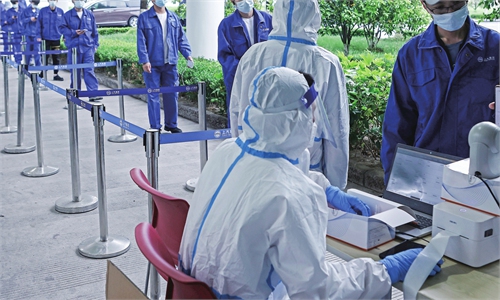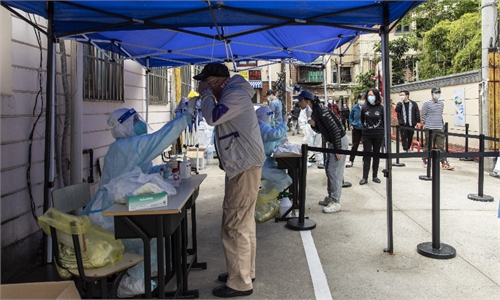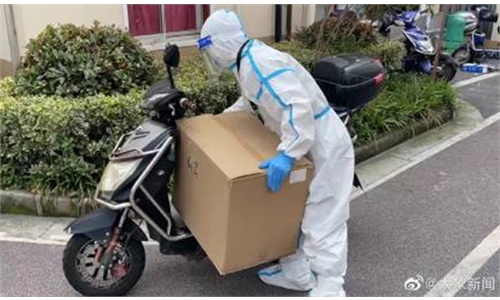Shanghai to ease restrictions in areas under zero-COVID status; a ‘major step toward lifting lockdown’

A view of Shanghai.Photo:VCG
After the lockdown dragged into its fifth week, Shanghai has recorded a drop in the numbers of cases for consecutive days. The city on Wednesday decided to take what epidemiologists said was "a major step toward lifting the lockdown" to ease restrictions in areas where COVID-19 infections were stamped outside the quarantined areas.
As infection cases continue to drop, the surging number of patients in severe condition poses another severe challenge for Shanghai to cope with in the upcoming COVID-19 battle. Experts believe the pressure of treating those patients on Shanghai's medical system will be short-lived, as the metropolis ramps up efforts to expand ICU beds and is propped up by medical experts nationwide.
Shanghai's current situation also highlights the need to stick to the dymanic zero-COVID policy, said experts, pointing out if Shanghai, endowed with the country's best medical system, is in dire need of help facing rising numbers of severe cases, who will be there to offer help if other parts of China also have to battle the onslaught of the coronavirus?
In official figures released Wednesday, Shanghai reported a 20.1 percent drop in new COVID-19 cases over the last 24 hours to 1,606 confirmed cases and 11,956 silent carriers, marking its fourth consecutive day of declines.
Zhao Dandan, a deputy director of the Shanghai Municipal Health Commission, said at Wednesday's press briefing that 51 million tests were conducted in the past five days, and the rate of positive cases has been gradually dropping.
Areas that have been declared to have stamped out viral infections outside the quarantined areas could see some easing of restrictions and control measures.
A resident who gave his surnamed as Jin in Shanghai's Minhang district said his compound had allowed residents to roam freely within the compound since Tuesday, after he was confined in his home for 27 consecutive days. "I can go down for a limited period of time, but it's good enough for me now," said Jin.
Jin explained that the policies vary in different compounds, depending on whether positive cases had been detected in their buildings.
However, two residents, one from Jinshan and one from Chongming, the first two districts in the city to have achieved zero-COVID status outside the quarantined facilities and cordoned-off or controlled areas, said they haven't received any notice of policy changes.
Zhao declared on Wednesday that the city would begin another round of testing for its residents from Wednesday to Saturday to further tweak restrictive measures in certain areas.
Epidemiologists see Shanghai's latest measure as a major step for the financial center to gradually lift its lockdown, under carefully orchestrated measures. "Shanghai already saw its inflection point during the second week of April, when numbers of daily cases topped 25,000. Since then, the numbers have been declining," an expert from the Chinese Center for Disease Control and Prevention (Chinese CDC), who requested anonymity, told the Global Times on Wednesday.
Shanghai's new positive cases reported for Tuesday account for roughly 94 percent of the national Tuesday tally.
The Chinese CDC expert admitted that risks of infections bouncing back is possible with the relaxation of control measures in Shanghai, especially given that the COVID-19 outbreaks are scattered around the country. Yet the quarantine cannot be sustained forever. "The key is to taking careful control of the situation," said the CDC expert.
In battling COVID-19, Shanghai should also focus on guaranteeing people's daily lives, social stability and treatment of patients with other diseases, Zeng Guang, former chief epidemiologist of Chinese CDC, also warned.
Shanghai is hastening its efforts in bringing the financial center back to normal, with factories resuming production under strict COVID-19 control measures. The Shanghai Municipal Postal Administration recently issued permits for vehicle drivers, which also shows the city is close to full resumption of delivery services. News portal thepaper.cn reported on Wednesday that Shanghai's postal services are mainly in charge of transferring life necessities.
A severe issue
As infection cases taper off, Shanghai has seen a surge in severe cases and deaths. By Tuesday, Shanghai has reported 238 deaths during this round of outbreak, raising the city's mortality rate to 0.045 percent. The city has also recorded 271 patients in severe condition as of Tuesday, media reported.
Epidemiologists predicted deaths and severe cases will keep climbing for a period of time, which will bring Shanghai a severe challenge, given the city's relatively low vaccination rate among its elderly people.
Most people, after being infected with coronavirus, can recover after five to seven days; about 8 percent of the infected will develop pneumonia. Among them, those with underlying conditions are more likely to suffer from severe symptoms, Lu Hongzhou, head of Shenzhen's anti-epidemic expert team and head of the Third People's Hospital of Shenzhen, told the Global Times.
He said that the health condition of patients with underlying diseases will rapidly deteriorate when entering the second week of infection, and that's why the peak of deaths and severe cases always lags behind that of the infection curve.
"The challenges of treating vulnerable groups are beginning to emerge, particularly because of the increase in the number of cases," Zhang Wenhong, a specialist in infectious diseases at Shanghai's Huashan Hospital and head of the expert panel addressing COVID-19 treatment in the city, told media on Monday. He admitted treating such patients was straining medical resources.
Yet both the above-quoted Chinese CDC expert and Lu are confident that pressure on Shanghai's medical system will be short-lived.
According to Weguan Erjian, the WeChat account of Shanghai Construction Group, Shanghai New International Expo Center, which has been turned into the city's centralized quarantine site, has eight emergency rooms, which can provide 2,160 beds for patients in severe conditions.
A total of 360 medical experts from the rest of the country have arrived in Shanghai to help the city treat patients with serious symptoms.
Jin Dongyan, a biomedical professor at the University of Hong Kong, is also optimistic that Shanghai will have abundant medical resources to deal with severe cases. "Shanghai can borrow from the experience of Hong Kong, to halve the medical resources - half to the COVID-19 patients and half to the non-COVID patients. At the same time, it can speed up the use of antivirus medicines, to effectively prevent severe cases and deaths," said Jin.
Lesson for rest of the country
Zeng pointed out that it is the nationwide support that is helping Shanghai stay away from a shortage in medical resources. But what if many cities have to face the onslaught at the same time?Will there be enough medical resources to cope with those patients?
When the US was savaged by an Omicron wave in early January, in 18 states at least 85 percent of adult intensive care unit beds were in use, while in 24 states at least 80 percent of staffed hospital beds were occupied, media reported.
A paper published by Fudan School of Public Health in 2021 said that China on average had only 4.37 ICU beds per 100,000 in 2021. In contrast, the US had 34.2 ICU beds per 100,000 as of 2015, according to the National Center for Biotechnology Information.
Based on those premises, epidemiologists believe China's current zero-COVID policy, which emphasizes early detection and early treatment, will avert the surge in severe cases.
The most direct and devastating consequence of a premature easing of COVID-19 restrictions will be the pressure on our medical system, said Zeng.




